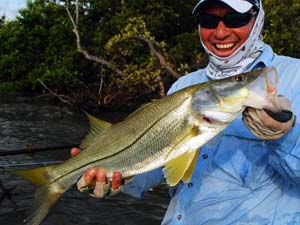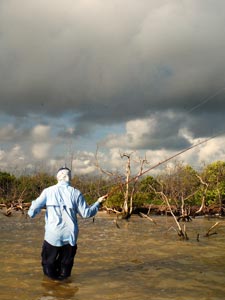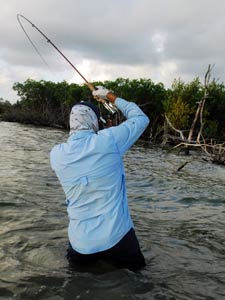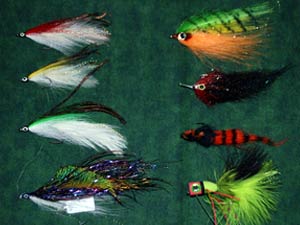
Fishermen have long been dazzled by the incredible beauty of the slender silver, black and yellow bodies of snook. Their sporting qualities have been argued by the best anglers on earth, thus their inclusion in the saltwater Super Slam. Throw in the tropical paradises where snook roam and you have the ingredients for a grand saltwater fishing adventure.
 |
| Capt. Rodman Hunter hoists a hefty snook he pulled from mangrove tangles while wading off the coast of Isla Blanca while wade fishing. |
Snook are ample adversaries on any type of tackle, but the ultimate snook fishing challenge comes from stalking them with a flyrod in hand.
Flyfishing for snook has been on my bucket list for a long time. I struck it off recently, but put it on the list again after the feisty fish thoroughly thrashed me on my first attempt. "Flyfishing for snook is not easy," said Capt. Rodman Hunter of Cancun Flyfishing. "Fishermen often come here with preconceived ideas about how they will go about flyfishing for snook. I book a lot of five day trips and require my clients to spend the first two days on the dock learning the proper methods to be successful."
Because of time limitations I had to skip the two days of instruction on the dock. Capt. Hunter taught as we went. It was not pretty. Accustomed to casting 40 to 50 feet at a leisurely pace, I learned quickly that preparation and practice before hand is an absolute necessity prior to tackling snook with a flyrod.
"The window of opportunity to take a shot (cast) at a snook is very narrow," Capt. Hunter had explained via e-mail prior to my trip. I have been fortunate enough to enjoy a grand variety of outdoor adventures in my lifetime and have adapted to the techniques of countless guides. However, the levity of Capt. Hunter's statement didn't soak in until my moment of truth.
Capt. Hunter's Maverick flats boat drifted to a halt in the backcountry waters of Isla Blanca, 30 miles north of Cancun, Mexico. Eagerly, I stepped up on the bow while Hunter manned the poling tower. My Temple Fork 9 weight flyrod felt good in my hand. Stretched out coils of fly line, at the ready and off of my feet, lay on the deck.
A daunting maze of downed mangrove trees lay like skeletal remains in the gin-clear waters along the sandy shoreline. Every laydown looked like it should have a snook hiding in its cover.
"There, 80 feet at three o'clock. Two snook. See them?" Hunter snorted.
"No, I don't see them," I whispered. "Now I do," I chortled as the two 20 pound fish, now 50 feet away and too close, streaked for cover.
"You spooked them!" echoed Hunter's charge. "You shuffled your feet. Don't move your feet. Don't turn your body. Bill, stealth is the name of this game. I have seldom caught a snook which saw me first. You have got to see them, play out line quickly and cast to them quickly and accurately. Remember, the window of opportunity is VERY narrow. The chance for a shot is here one second and gone the next."
 |
| Fishing for snook in the tangles of the mangrove swamps requires superb fly casting skills, including casts of 80 feet or more. |
A couple of minutes later Hunter found two more snook. "Point your rod tip to two o'clock, now", he instructed. "There, right behind the double trees. Cast, cast, cast. Now!"
"Too short. Cast again. You're losing them. Shoot now," Hunter insisted.
By the grace of God my Deceiver fly zoomed through the tangle of mangroves and landed eight feet in front of the two large snook. "Strip, strip, strip faster," Hunter coached.
The pair of fish sped towards the fleeing fly like twin torpedoes. "He got it! Set the hook!" Hunter yelled.
I put all the muscle I had into the set and simultaneously felt my fingers burning as the powerful fish ripped line from my fly reel. A resounding "ping" echoed across the water as the 20 pound test tippet popped like a soap bubble.
"Incredible!" I yelled. "Wow, I've never seen anything like that. Those fish are powerful. That one sure beat me up."
Ten minutes later, I repeated the process and wrestled a 25 pound snook free of the mangrove snags. Confidence welled up inside of me as I felt the powerful lunges of the fighting fish on the end of my line. I knew I would wear this one down and bring it to hand. My arrogance faded quickly as the fish turned on a dime and sped towards the boat. My line went limp right along with my ego.
My skills improved with each encounter. I slipped into super stealth mode, scanning the shallow waters for horizontal black lines in a world of vertical stickups. "You need better sunglasses," Hunter pointed out. "In the future, buy only the best — Costa del Mars. They are absolutely necessary for this type of fishing."
Snook are known to have extremely sensitive sensor cells lining their lateral line. Therefore, a quiet approach is paramount to obtaining a shot at a fish. Playing the current and knowing the water temperature and water depth gives an angler several advantages. Cold water transmits sound better than warmer water. Current is like wind in the water. If the current is flowing the way you are traveling, fish will hear you easier and spook.
Light angle is another important fact to consider when approaching snook. Three important phases of light occur each day: sunrise, overhead and sunset. It is best to have the brightest light to your back. It will help you spot fish and at the same time make it difficult for fish to spot you. They will be looking into the light source. A downside to this scenario is the fact that your fly must be placed closer to the fish, because they are having difficulty seeing well. A fly must be worked slower, too, to give a fish ample opportunity to spot the offering.
Flyfishing for snook quickly converted me into an adrenaline junky. The excitement of hunting the fish, approaching it with utmost stealth, presenting a fly to the right spot and watching the lanky fish attack ranked right up there with the best of my outdoor adventures.
 |
| Flyrods in the 8 to 11 weight class are required to maneuver big snook out of the mangrove laydowns. |
Two days later, Capt. Hunter and I returned to the snook hangout and tried our luck again. Waves pounded the shoreline. "We will have to wade," Capt. Hunter pointed out. "Wading is actually the best way to approach snook. I only use the boat when the water is deep or the bottom is too soft to wade, or when the mangrove tangles are too thick."
I chose to pack my camera instead of my flyrod. I knew instantly that fishing the turbid waters would be the ultimate challenge and I wanted to capture it on film. Hunter approached every stickup in a crouched position to keep a low profile. "I'll have to put the fly right on their nose to entice a strike," Hunter explained.
Thousands of stickups made the fishing task appear daunting. Hunter patiently and stealthily approached likely looking lairs and laid his fly near them. He successfully caught several 3 to 4 pound snook in 30 minutes. Then he set the hook with muscle. The water erupted with a spray of saltwater. "Much bigger fish," he laughed. I struggled to keep up as the fish raced through the tangles with hunter in tow. The powerful snook finally hit a tangle of roots and wrapped the leader. Capt. Hunter strode rapidly through the thigh-deep water and thrust his free hand into the mangrove tangles and yanked out a splendid ten-pound snook. We both danced with excitement.
After photographing the snook, we headed back to the boat. I took the opportunity to quiz Capt. Hunter about several aspects of snook fishing including rods, reels, lines, flies and presentations. His response would fill a book. Needles to say, there is not room for that much information here. Following are the essentials for anyone considering getting into flyfishing for snook and other saltwater species.
Snook range from very small up to 60 pounds. Five to six weight rods will work for the smaller fish; however, a wind of over 5 knots will make it difficult to utilize the lighter rods. Hunter says the best all-purpose weight rods to use are sizes 8 through 11. You'll want to focus your search on fast-action saltwater fly rods; a fast action is necessary to generate the high line speeds needed for quick, long, spot-on presentations to snook 80 feet out from the boat.
Good drags and plenty of room for backing are musts for a saltwater fly reel. The drag helps an anlger control the fish and keep it out of the tangles. In open water, fishermen need both a good drag and lots of backing to subdue a big snook.
"Even the best saltwater fly lines must be cleaned often to prevent friction, which slows down the cast," Hunter said. The Cortland tropical saltwater lines are among the best in full color and floating lines, according to Hunter. Additionally, he recommends clear floating fly lines, which he says are the best lines ever made. He adamantly stated that he had increased his catch rate strikes by 50 percent since he began using Cortland PE+.
Flies for snook are easy to select. "Simply match the hatch," Hunter said. But, the best snook flies will include the floating flies: snook-aroo, gurlers, poppers, gummy minnows, and shrimp and crab patterns. Sinking flies should include deceivers, seahabit, puglisis sardine, mullets and bunkers, supreme hair shrimp and gummy minnows.
Most saltwater flies are not made with weed guards. It is worth the extra money and effort to buy flies with guards. If you can't find them, fashion your own guards out of heavy mono and glue. It will save a lot of lost flies and ultimately result in more hooked fish.
 |
| A good assortment of snook flies includes a variety of colors of the deceiver pattern (L) and (R) Rainy's Firetiger Baitfish, Calliente, Tarpon Toad and Poppers. |
Presentation of flies to snook in heavy cover is a subject which needs a book to thoroughly cover the possibilities. I understand overhead and sidearm casts, but when Capt. Hunter began talking about making sidearm cast and delivering flies with an overhead-inverted delivery...well, I knew I would eventually have to spend the two days on the dock, because that delivery is the stealthiest of all deliveries. I clearly remember spooking fish when my flies splashed heavily in front of them!
Clothing is another very important item when pursuing snook with a fly rod. Colors should match the sky behind you, usually sky blue or light blue. Matching buffs and gloves are essential as well. Long sleeve shirts and long pants help to cover up shiny skin.
A quick way to evaluate your guide is to check the color and style of his fishing boat. The hull of the boat should be blue where it meets the water, so it blends into the water and sky. Brightly colored sides will be seen by fish looking upwards. The name of the game is about stealth, and the boat has to handle the task, otherwise any noise (water slapping the boat) decreases chances for a shot to the point of spooking all fish out of the area or alerting your intended targets. Too, guides should be running the best flats boats available. Anything less will not get you to the skinny water where many of the biggest snook hide.
In spite of the tips in this article, the best thing you can do to properly prepare for the ultimate snook fishing challenge is to book a trip with a guide. Capt. Rodman Hunter is one of the best guides in the business, and the tough education he provides will stick with you the rest of your life. Capt. Hunter is death on detail and will prepare you for what is to come.
The snook may have won the first round I spent with them, but I am practicing with a vengeance. The next time Capt. Hunter takes me out, I will be able to swiftly make that 100 foot, pin-point accurate cast that he demands.
- 14109 views

